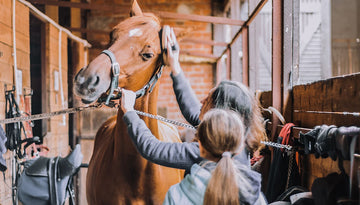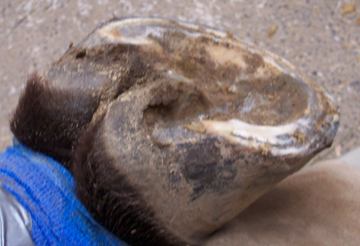The definition of an abscess is a localized collection of pus in a cavity formed by the disintegration of tissue.1 Hoof abscesses are usually caused by a bacterial infection. Dead white blood cells and bacterial matter create a buildup of pus, which creates pressure. Since the sensitive structures are encased within the hoof, the buildup of pressure sometimes creates excruciating pain for the horse.1,3,4,5,8
Abscesses in the hoof are typically characterized by sudden onset of lameness, a reluctance to bear weight on the foot (broken leg syndrome), limb pointing, and a tendency to walk on the toe of the hoof. The horse may be sensitive around the area of the abscess and may have an increased digital pulse, increased heat, and swelling in the lower leg.2,3,4,5,6,7,8
If left untreated, the abscess may follow the path of least resistance and erupt on its own through the sole, hoof wall, or the coronary band. However, the infection can become deeper and more widespread which is why early treatment is best.5,6,8
Causes of Abscesses
Abscesses are more commonly seen during the wet spring and fall months and can some plague horses year-round or with other lameness issues. Moisture in the environment can soften regions of the foot and make it easier for bacteria to get trapped inside. Extremely dry conditions can cause brittle, cracked and bruised feet. The abscess-causing bacteria enter the foot through hoof cracks, by traveling up the white line, though penetrating wounds to the foot, and even by close or misplaced horseshoeing nails.3,4,5
Any object capable of penetrating the sole (example - sharp rocks, nails, wood splinters) can create the entrance point for a bacterial invasion.3,4,5 If a nail or object is seen penetrating the sole or frog, DO NOT remove it and call your veterinarian immediately!
Types of Abscesses
There are two types of hoof abscesses. Submural abscesses and subsolar abscesses. Submural abscesses are under the hoof wall and typically exit out at the coronary band. Subsolar abscesses are under the sole and typically exit at the white line, bars, or heel bulbs.7
Abscesses can extrude several different types of material and color including most often Black/Brown or Grey, as well as Clear (serum), or Reddish (blood mixed serum). White liquid from the frog which involves merocrine gland infections or release and is not an abscess.9
Treatment for abscesses from penetrating wounds (nails, screws, wood splinters) by the Horse Owner
As stated earlier, if a nail or object is seen penetrating the sole or frog, DO NOT remove it and call your veterinarian immediately! Wrap the foot if needed and get the horse into a deeply bedded stall. Keep the horse calm until the veterinarian arrives. There is a natural reaction to want to pull out the penetrating object however this can complicate diagnosis, prognosis, and treatment by the veterinarian.4,7
Treatment for abscesses from non-penetrating wounds by the Horse Owner
The goal of treatment by the horse owner is to drain the abscess and prevent further infection. Treatment options come down to two approaches, soaking or poulticing.
Soaking involves soaking the hoof in hot water and Epsom salts. The water helps soften the foot and the Epsom salts work on drawing out the abscess through osmotic pressure.10 Soaking may not be an option for horse owners due to the horse moving around and spilling the soaking solution or not wanting to stand with their foot in a bucket for a length of time.
Poulticing seems to be a much easier solution for many owners as they can apply the poultice and allow the horse to move around at will as the poultice is continuously working to draw out the abscess. There are several commercially available poulticing products as well as many homemade remedies. Epsom salt gel, Ichthammol, and Animalintex®a are some more commonly used abscess poultices.
Epsom salt gel is a commercially available product that is usually applied all over the sole,frog,and bulbs, then the foot is wrapped. A common homemade remedy is a poultice paste made from sugar and iodine or Betadine®b solution. Both Epsom salts and Sugar work by changing osmotic pressure, which means it will draw the infection out. The Betadine®b is added as a disinfectant. Ichthammol is also a commercially made product that is a schist oil extract such as ammonium bituminosulfonate and sodium bituminosulfonate that is used as an abscess drawing salve.10
Changing bandages daily is recommended to inspect if the abscess has broken out. When the abscess bursts, the pus will come out, and the horse will have immediate relief. The open wound needs to fill with granulation tissue, which takes about three to four days. Once the granulation tissue is in place you don’t need to bandage anymore.3,6,7
Recovery time for an abscess
Horses with a mild abscess infection can return to work in less than a week. Deep infections can take several weeks to heal and may lead to other complications if not taken care of.3,4
When to get your Veterinarian and Farrier Involved
Call your veterinarian if the infection continues to drain or drains more after 48 hours, the horse remains in pain for more than one to two days, the horse doesn’t want to eat, the horse lies down more than normal, or tissue (proud flesh) grows out of the drain hole.3,7
Some difficult abscesses may require your veterinarian and farrier to provide further intervention and prevent further damage.5 They may need to use further tools in order to determine the abscess location or rule out other lameness issues. If the abscess cannot be located, the veterinarian may have to take radiographs to help locate the abscess. Once the abscess is located, they may have to pare out the abscess by cutting a hole just large enough to drain the abscess. The veterinarian may prescribe analgesics or pain killers and provide further treatment options.3,4,5,8
Conclusion
Watching your horse experience the pain of an abscess can be traumatic. While hoof abscesses can be extremely painful, they usually resolve easily with treatment within three to five days. Many abscesses can be prevented, and most are simple to cure if you get your veterinarian and farrier in the loop early.

Example of abscess blowouts at the heel bulbs and hoof wall.

Example of an abscess extruding or draining black pus.
References and Resources
1. Saunders Comprehensive Veterinary Dictionary. Blood and Studdert, 1999.
2. Gregory’s Textbook of Farriery, Chris Gregory, CJF, FWCF. Ch 45-1, page 403- 412.
3. University of Minnesota Extension. Horse Hoof Abscesses. https://extension.umn.edu/horse-health/hoof-abscesses
4. American Association of Equine Practitioners. Hoof Abscesses. https://aaep.org/horsehealth/hoof-abscesses
5. Horse Sport. Hoof Abscesses. https://horsesport.com/magazine/hoof-care/hoofabscesses/#:~:text=Treating%20abscesses%20involves%20soaking%20and%20p oulticing.%20Soaking%20with,while%20the%20horse%E2%80%99s%20foot%2 0soaks%2C%20we%20poultice%20it
6. Horse Canada. The Best Way to Treat Abscesses. November 8, 2018. https://horse-canada.com/magazine/hoof-care/the-best-way-to-treat-abscesses
7. TheHorse.Com. Hoof Abscesses. https://thehorse.com/wpcontent/uploads/2018/04/AAG_Abscesses_ab_MNA_.pdf#:~:text=There%20are %20two%20common%20types%20of%20hoof%20abscesses%3A,wall%2C%20 which%20typically%20vent%20at%20the%20coronary%20band
8. Purdue University Veterinary Hospital. Equine Hoof Abscesses. https://vet.purdue.edu/vth/large-animal/equine-health-tip-equine-hoofabscesses.php
9. Merocrine Glands in the Frog. Esco Buff, PhD, APF-I, CF. https://www.facebook.com/EscoBuffsProfessionalFarrierServiceLLC/posts/28748 18492775576
10. Ichthammol vs Epsom Salts. HTTP://ESCOBUFF.COM/ICHTHAMMOL-VSEPSOM-SALTS.HTML
- Animalintex® Hoof Poultice, Marketed by 3M, 1395. https://www.3m.com/3M/en_US/p/d/v000154311
- Betadine© 2022 Avrio Health L.P. Betasept and Betadine are registered trademarks of Avrio Health L.P.









